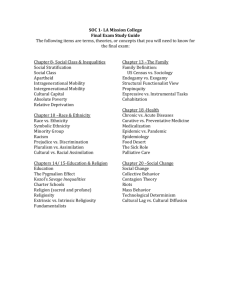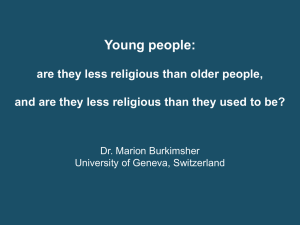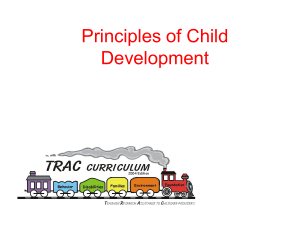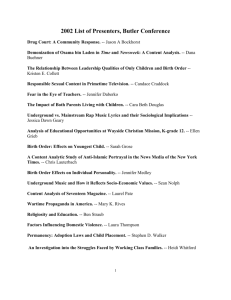Who Benefits from Religion? Daniel Mochon Michael I. Norton Dan Ariely
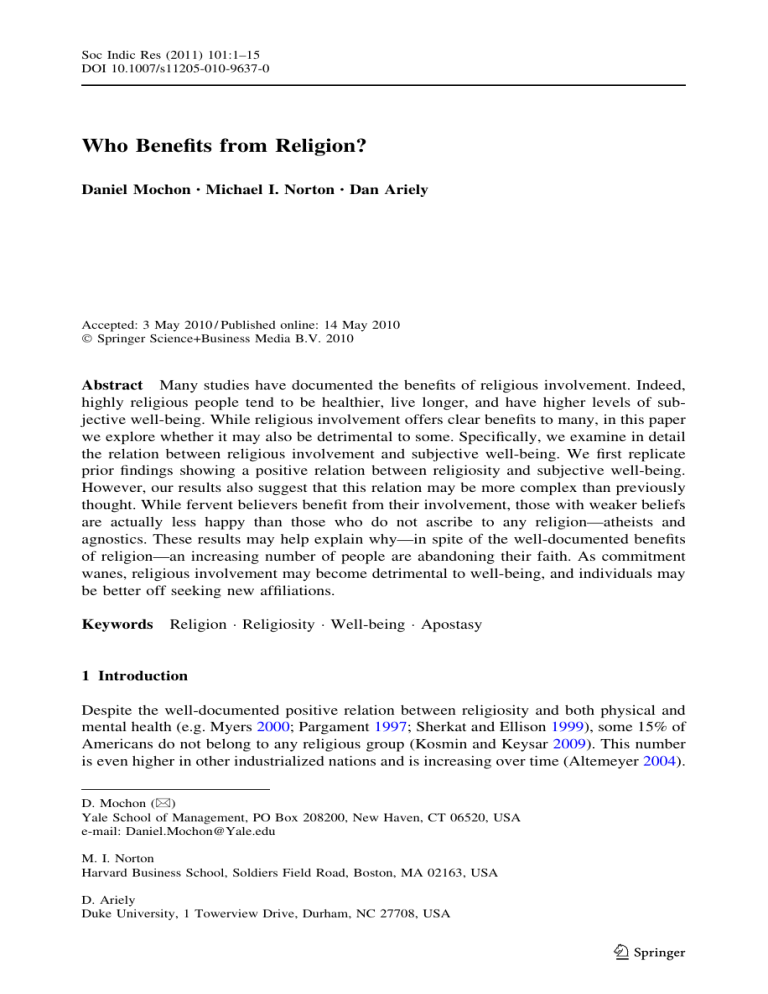
Soc Indic Res (2011) 101:1–15
DOI 10.1007/s11205-010-9637-0
Who Benefits from Religion?
Daniel Mochon • Michael I. Norton • Dan Ariely
Accepted: 3 May 2010 / Published online: 14 May 2010
Ó Springer Science+Business Media B.V. 2010
Abstract Many studies have documented the benefits of religious involvement. Indeed, highly religious people tend to be healthier, live longer, and have higher levels of subjective well-being. While religious involvement offers clear benefits to many, in this paper we explore whether it may also be detrimental to some. Specifically, we examine in detail the relation between religious involvement and subjective well-being. We first replicate prior findings showing a positive relation between religiosity and subjective well-being.
However, our results also suggest that this relation may be more complex than previously thought. While fervent believers benefit from their involvement, those with weaker beliefs are actually less happy than those who do not ascribe to any religion—atheists and agnostics. These results may help explain why—in spite of the well-documented benefits of religion—an increasing number of people are abandoning their faith. As commitment wanes, religious involvement may become detrimental to well-being, and individuals may be better off seeking new affiliations.
Keywords Religion Religiosity Well-being Apostasy
1 Introduction
Despite the well-documented positive relation between religiosity and both physical and mental health (e.g. Myers
2000 ; Pargament 1997 ; Sherkat and Ellison 1999
), some 15% of
Americans do not belong to any religious group (Kosmin and Keysar
). This number is even higher in other industrialized nations and is increasing over time (Altemeyer
D. Mochon (
&
)
Yale School of Management, PO Box 208200, New Haven, CT 06520, USA e-mail: Daniel.Mochon@Yale.edu
M. I. Norton
Harvard Business School, Soldiers Field Road, Boston, MA 02163, USA
D. Ariely
Duke University, 1 Towerview Drive, Durham, NC 27708, USA
123
2 D. Mochon et al.
Why would a practice that offers such clear benefits not be universally adopted? While skepticism about specific doctrines clearly plays a role (e.g. Altemeyer
and Hunsberger
; Exline
; Hunsberger and Brown
), we suggest that one reason may be that the benefits of religiosity are not attained by all adherents: While those who believe strongly are very happy, those who believe weakly are less happy and may even be hurt by their affiliation to a religious group.
In this paper we will propose that the relation between religious involvement and wellbeing may be non-linear and more complex than previously thought. While some may benefit from becoming more religious, others may attain higher levels of well-being by reducing their religious involvement. Indeed, weakly affiliated adherents may actually be less happy than their unaffiliated counterparts—atheists, agnostics, and those who report no religion at all—and therefore would appear to benefit from abandoning their faith.
2 The Benefits of Religion
Religious involvement has been shown to provide a wide range of benefits at both the individual and societal level. At the societal level, higher religious involvement is related to increased levels of education (Gruber
), lower crime rates (Baier and Wright
Johnson et al.
2000 ), increases in civic involvement (Putnam
; Ruiter and De Graaf
2006 ), higher levels of cooperation (Norenzayan and Shariff 2008 ; Shariff and Norenzayan
2007 ), lower divorce rates, higher marital satisfaction and better child adjustment (Ma-
honey et al.
2001 ; for a review, see Sherkat and Ellison 1999 ).
At the individual level, many studies have shown that religion is linked to various measures of physical health, such as lower rates of coronary disease, emphysema and cirrhosis (Comstock and Partridge
1972 ), lower blood pressure (Larson et al.
), and longer life expectancy (George et al.
; Idler and Kasl
Koenig
; Litwin
2007 ; Plante and Sherman 2001 ; Seybold and Hill
2001 ) Researchers investigating a wide array of psychological disorders—such as
depression—have generally found religious involvement to be related to better mental health as well (Hackney and Sanders
; Kendler et al.
; Larson et al.
et al.
).
Finally, there is ample evidence that religion is positively related to higher levels of
subjective well-being. Myers ( 2000 ) reports data from a national sample showing that
those who are most involved with their religion are almost twice as likely to report being
‘‘very happy’’ than those with the least involvement (see also Ferris
), while Ellison
(
) found that religious variables accounted for 5–7% of variance in life satisfaction
(see also Witter et al.
). It is likely that a number of factors underlie the link between religiosity and well-being, from the social support and prosocial behaviors that religion encourages (Barkan and Greenwood
; Cohen
; Taylor and Chatters
coherent framework that religion provides (Ellison et al.
; Pollner
mechanisms that alleviate stress and assuage loss (McIntosh et al.
; Pargament
Pargament et al.
; Strawbridge et al.
). One recent investigation traced the benefits of religious involvement to the cumulative effect of the positive boosts in wellbeing that people receive each time they attend religious services (Mochon et al.
).
While religious involvement has clearly been shown to offer benefits to many, little research has focused on how involvement may hurt some adherents. In the following study, we will collect data from a national sample of Americans, and get measures of both religious involvement and subjective well-being. We will then explore in detail the relation
123
Who Benefits from Religion?
3 between involvement and well-being, and compare it to the well-being of non-adherents in order to examine whether some people may be harmed by their religious involvement, and may benefit from reducing their levels of commitment to their faith.
3 Method
3.1 Data Collection
In order to examine the relation between religious involvement and subjective well-being we conducted an online study using a survey company that maintains a panel of over one million Americans. While the sample is not truly representative, it offers a good cross section of the American population. Respondents ( N = 6,465) included people from all 50 states and Washington D.C. In the survey we collected various demographic measures, as well as measures of subjective well-being and religious involvement.
3.2 Demographics
We collected from each respondent a measure of their:
1.
Age.
2.
Gender.
3.
Ethnicity based on five categories: (a) African-American; (b) Asian; (c) Hispanic; (d)
White; (e) Other.
4.
Marital status based on four categories: (a) single, never married; (b) married; (c) separated, divorced or widowed; (d) domestic partnership.
5.
Education level based on seven categories: (a) completed some high school; (b) high school graduate; (c) completed some college; (d) college degree; (e) completed some postgraduate work; (f) master’s degree; (g) doctorate, law or professional degree.
6.
Household income based on nine categories: (a) less than $20,000; (b) $20,000–
$29,999; (c) $30,000–$39,999; (d) $40,000–$49,999; (e) $50,000–$59,999; (f)
$60,000–$74,999; (g) $75,000–$99,999; (h) $100,000–$149,999; (i) $150,000 or more.
7.
Political affiliation based on three categories: (a) Democrat; (b) Republican; (c) Other.
3.3 Measures of Religion and Religiosity
We assessed religiosity using a scale developed by Blaine and Crocker ( 1995 ). Scores on
this scale range from 1 (least religious) to 7 (most religious). Respondents were also asked to indicate their religion via an open ended question; these responses were later reclassified into the 20 most common religious groups among our respondents, including a category of
‘‘Other’’ for all respondents whose religious affiliation did not fall into one of these categories. The participants in these 20 groups comprise our ‘adherents’. In addition, we created categories for respondents who indicated that they were Atheists, Agnostics, or claimed to have no religious affiliation (‘‘None’’). The participants in these three groups comprise our ‘non-adherents’. Table
shows the number of respondents belonging to each group.
123
4
Table 1 Number of respondents in each religious group
Religion
Agnostic
Atheist
Baptist
Buddhist
Catholic
Christian
Episcopalian
Hindu
Islamic
Jehovah’s witness
Jewish
Lutheran
Methodist
Mormon
No Religion
(Eastern) Orthodox
Other
Pagan
Pentecostal
Presbyterian
Protestant
Spiritual
Unitarian
Wiccan
3.4 Measures of Well-Being
We collected seven measures of well-being: (1) Life satisfaction (Diener et al.
); (2)
Hopelessness (Beck et al.
1974 ); (3) Depression (Beck et al.
(Rosenberg
1965 ); and asked respondents to rate on a 1–100 scale (5) ‘‘How do you feel
right now?’’; (6) ‘‘How satisfied are you with your life in general?’’; and (7) ‘‘How satisfied are you with your spiritual and religious life?’’. Table
shows the descriptive statistics of all the variables collected.
D. Mochon et al.
Number of respondents
267
115
593
24
74
37
404
343
1,384
1,294
96
17
133
68
615
35
391
52
26
50
211
55
88
95
4 Results
Because of the high degree of correlation among our various measures of well-being, we created a composite measure based on the averages of the z-scores of the seven measures
(Cronbach’s a = .89) and used this well-being composite as the main dependent variable in our analyses.
We first sought to replicate prior research showing a positive relation between subjective well-being and religious involvement. Table
shows a series of OLS regressions we ran in order to test the robustness of this relation. Model 1 examines the effect of religiosity after controlling for some basic demographic factors (Age, Gender, Ethnicity
123
Who Benefits from Religion?
5
Table 2 Descriptive statistics for the individual-level variables
Variable
Well-being composite
Life satisfaction
Hopelessness
Depression
Self esteem
Feel now
General satisfaction
Spiritual satisfaction
Religiosity
Age
Gender (ref. male)
Ethnicity
African American
Asian
Hispanic
White
Other
Marital status
Single
Married
Separated
Partnership
Educational level
Some high school
High school graduate
Some college
College degree
Some post-graduate
Masters
Doctor
Household income
Less than $20,000
$20,000–$29,999
$30,000–$39,999
$40,000–$49,999
$50,000–$59,999
$60,000–$74,999
$75,000–$99,999
$100,000–$149,999
$150,000 and up
Political affiliation
Democrat
Republican
Other
Mean SD Minimum Maximum
0
4.45
0.74
0.45
0.78
3.0
1.5
1
0.25
0.44
0
0
0.89
0.74
2
68.65
26.58
0
68.35
25.98
71.19
28.02
0
0
4.70
1.83
43.86
13.71
0.76
0.43
1
18
0
2
100
100
100
1
3
1.22
7
7
92
1
0.05
0.02
0.01
0.84
0.08
0.21
0.54
0.18
0.06
0.02
0.17
0.39
0.25
0.06
0.09
0.03
0.14
0.14
0.14
0.13
0.11
0.12
0.11
0.08
0.03
0.37
0.30
0.32
0.21
0.15
0.11
0.37
0.27
0.41
0.5
0.38
0.24
0.12
0.37
0.49
0.43
0.23
0.29
0.16
0.35
0.35
0.34
0.34
0.31
0.32
0.32
0.26
0.17
0.48
0.46
0.47
0
0
0
0
0
0
0
0
0
0
0
0
0
0
0
0
0
0
0
0
0
0
0
0
0
0
0
0
1
1
1
1
1
1
1
1
1
1
1
1
1
1
1
1
1
1
1
1
1
1
1
1
1
1
1
1
123
6 D. Mochon et al.
Table 3 Regression models of the effect of religiosity on well-being
Model 1
B (SE)Sig.
Beta
Model 2
B (SE)Sig.
Beta
Model 3
B (SE)Sig.
Beta
(Constant)
Religiosity
Age (in years)
0.677
(0.053)***
0.077
(0.005)***
0.005
(0.001)***
0.181
0.087
1.109 (0.092)***
0.08 (0.005)***
0.004 (0.001)***
0.188
0.074
1.056 (0.105)***
0.084 (0.006)***
0.004 (0.001)***
0.199
0.077
Gender (ref. male) 0.048
(0.023)*
Ethnicity (ref. other)
African American
Asian
Hispanic
White
0.184
(0.054)***
0.11
(0.071)
0.001
(0.094)
0.06
(0.035)
Marital status (ref. single)
Married 0.143
(0.026)***
0.026
0.051
0.021
0.000
0.029
0.092
0.01 (0.023)
0.191 (0.054)***
0.084 (0.07)
0.044 (0.093)
0.065 (0.035)
0.078 (0.027)**
0.006
0.053
0.016
0.006
0.031
0.05
0.007 (0.023)
0.207 (0.055)***
0.08 (0.072)
0.055 (0.093)
0.073 (0.035)*
0.084 (0.027)**
0.004
0.057
0.015
0.008
0.035
0.054
Separated
Partner
0.025
(0.033)
0.015
(0.043)
0.012
0.005
Educational level (ref. some high school)
0.006 (0.032)
0.01 (0.043)
0.21 (0.078)** High school graduate
Some college
College degree
Some post-graduate
Masters
Doctor
Household income (ref.
\ $20 K)
0.262 (0.076)***
0.369 (0.077)***
0.003
0.003
0.101
0.164
0.206
0.007 (0.033)
0.004 (0.043)
0.205 (0.078)**
0.252 (0.076)***
0.36 (0.077)***
0.003
0.001
0.099
0.158
0.201
0.395 (0.084)*** 0.119
0.384 (0.084)*** 0.115
0.395 (0.081)*** 0.145
0.385 (0.082)*** 0.141
0.243 (0.096)* 0.049
0.236 (0.096)* 0.048
$20,000–$29,999
$30,000–$39,999
$40,000–$49,999
$50,000–$59,999
$60,000–$74,999
$75,000–$99,999
$100,000–$149,999
$150,000 and up
Political affiliation (ref. other)
Democrat
Republican
0.014 (0.035)
0.024 (0.035)
0.074 (0.036)*
0.173 (0.038)***
0.207 (0.038)***
0.239 (0.038)***
0.006
0.011
0.033
0.069
0.086
0.098
0.011 (0.035)
0.024 (0.035)
0.076 (0.036)*
0.172 (0.038)***
0.206 (0.038)***
0.24 (0.039)***
0.005
0.011
0.033
0.069
0.085
0.098
0.288 (0.044)*** 0.098
0.289 (0.044)*** 0.098
0.304 (0.061)*** 0.066
0.305 (0.062)*** 0.066
0.044 (0.023)
0.068 (0.024)**
0.027
0.04
0.051 (0.023)*
0.078 (0.025)**
0.031
0.046
123
Who Benefits from Religion?
Table 3 continued
Model 1
B (SE)Sig.
Beta
Model 2
B (SE)Sig.
Beta
Model 3
B (SE)Sig.
Beta
Religious affiliation (ref. other)
Agnostic
Atheist
Baptist
Buddhist
Catholic
Christian
Episcopalian
Hindu
Islamic
Jehovah’s witness
Jewish
Lutheran
Methodist
Mormon
No religion
(Eastern) Orthodox
Pagan
Pentecostal
Presbyterian
Protestant
Spiritual
Unitarian
Wiccan
R
2
0.064
0.051 (0.083)
0.14 (0.104)
0.137 (0.06)*
0.093 (0.136)
0.106 (0.055)
0.096 (0.055)
0.118 (0.091)
0.053 (0.191)
0.11 (0.101)
0.071 (0.133)
0.119 (0.064)
0.059 (0.065)
0.181 (0.068)**
0.026 (0.086)
0.066 (0.06)
0.201 (0.16)
0.078 (0.112)
0.115 (0.095)
0.079 (0.092)
0.112 (0.064)
0.13 (0.115)
0.16 (0.154)
0.163 (0.113)
0.102
0.098
Results of single level OLS regression. Dependent variable: subjective well-being composite. Sig:
* p \ .05; ** p \ .01; *** p \ .001
0.015
0.007
0.037
0.017
0.046
0.004
0.025
0.016
0.009
0.018
0.052
0.009
0.056
0.049
0.018
0.004
0.009
0.017
0.012
0.034
0.015
0.013
0.019
and Marital Status). Model 2 adds more extensive demographic controls (Educational
Level, Household Income and Political Affiliation). Finally, Model 3 also controls for the specific religious group each participant belongs to.
As the results clearly show, we replicate the positive relation between subjective wellbeing and religiosity, and this relation appears quite robust to model specification. As more demographic controls were added to the regression model, this relation changed little, and if anything, it became somewhat stronger. Interestingly, we find no large differences between the religions, as only 2 out of the 23 dummy variables for different religious groups showed a statistically significant effect ( p \ 0.05).
While the above results are consistent with prior work on the relation between religious involvement and subjective well-being, we wanted to further explore this relation to see who benefits from religious involvement. As an initial step we converted our continuous religiosity variable into a categorical one by rounding the scores to the nearest integer. We then plotted the average level of well-being for adherents (people belonging to a religious group) as a function of their religiosity category. We also included reference lines for the
123
7
8 D. Mochon et al.
Fig. 1 The well-being of religious adherents as a function of religiosity, plotted against the average wellbeing of Atheists, Agnostics, and respondents who reported no religion average well-being of Agnostics, Atheists and those who indicated not belonging to any religion. Two patterns clearly emerge from Fig.
. First of all, the relation between religiosity and well-being is non-linear. Second, many adherents (those with low levels of commitment) appear to have lower levels of well-being than their atheist and agnostic counterparts. We will explore each one of these findings next.
We first tested the non-linear relation by adding a quadratic religiosity variable into the regression models above. As it can be seen in Table
4 , there is a strong and robust
quadratic effect of religiosity on well-being (see also Diener and Clifton
people who are highly religious seem to have the highest levels of subjective well-being, those with more moderate belief seem to suffer from their religious involvement. We further tested this non-linear relation by substituting our continuous religiosity variables with the dummy categorical variables of religiosity we created above. Table
shows the regression models when these variables are included in the regression. The regression results closely mirror those in Fig.
1 . The most fervent believers clearly benefit from their
religious affiliation. People with religiosity levels of six and seven reported significantly higher well-being than the reference group (those with religiosity of one). However, people with levels of four and five showed no benefit over the least religious people in our sample, and in fact, people with moderate to low adherence (those with levels of two and three) showed a significantly negative effect of religiosity. Thus while religious involvement clearly benefits some (the most fervent believers) it can also be detrimental to others.
In a final analysis, we compared the average well-being of the non-affiliated with the well-being of those affiliated with a religious group. Based on the distribution of Fig.
, we estimated that some 47.3% of adherents are less happy than Atheists, 21.9% are less happy
123
Who Benefits from Religion?
Table 4 Regression models that include quadratic religiosity
Model 1
B (SE)Sig.
Beta
Model 2
B (SE)Sig.
Beta
Model 3
B (SE)Sig.
Beta
(Constant)
Religiosity
Religiosity
2
0.307
(0.068)***
0.133
(0.025)***
0.025
(0.003)***
0.315
0.508
-
-
0.723 (0.101)***
0.139 (0.025)***
0.026 (0.003)***
0.327
0.53
-
-
0.631 (0.116)***
0.138 (0.026)***
0.026 (0.003)***
0.325
0.534
Age (in years)
Gender (ref. male)
0.005
(0.001)***
0.048
(0.023)*
Ethnicity (ref. other)
African American
Asian
0.169
(0.054)**
0.111
(0.071)
Hispanic
White 0.065
(0.035)
Marital status (ref. single)
Married
0.019
(0.094)
Separated
0.14
(0.026)***
0.019
(0.033)
-
-
0.08
0.026
0.047
0.021
0.003
0.031
0.09
0.009
-
0.004 (0.001)***
0.011 (0.023)
0.172 (0.054)***
0.085 (0.07)
0.064 (0.092)
0.071 (0.034)*
0.073 (0.026)**
0.001 (0.032)
-
0.067
0.006
0.047
0.016
0.009
0.033
0.047
0.001
-
0.004 (0.001)***
0.008 (0.023)
0.193 (0.055)***
0.085 (0.072)
0.064 (0.093)
0.074 (0.035)*
0.08 (0.027)**
0 (0.032)
-
0.066
0.005
0.053
0.016
0.009
0.035
0.051
0
Partner 0.029
(0.043)
0.009
Educational level (ref. some high school)
0.021 (0.042)
0.21 (0.077)** High school graduate
Some college
College degree
Some post-graduate
Masters
Doctor
Household income (ref.
\ $20 K)
0.257 (0.075)***
0.362 (0.077)***
0.007
0.101
0.161
0.202
0.016 (0.043)
0.207 (0.077)**
0.005
0.1
0.25 (0.076)*** 0.157
0.352 (0.077)*** 0.196
0.388 (0.084)*** 0.116
0.377 (0.084)*** 0.113
0.386 (0.081)*** 0.142
0.375 (0.081)*** 0.138
0.242 (0.095)* 0.049
0.231 (0.096)* 0.047
$20,000–$29,999
$30,000–$39,999
$40,000–$49,999
$50,000–$59,999
$60,000–$74,999
$75,000–$99,999
$100,000–$149,999
$150,000 and up
Political affiliation (ref. other)
Democrat
0.014 (0.035)
0.029 (0.035)
0.006
0.012 (0.035)
0.013
0.028 (0.035)
0.005
0.012
0.074 (0.035)* 0.032
0.073 (0.036)* 0.032
0.172 (0.038)*** 0.069
0.169 (0.038)*** 0.067
0.221 (0.037)*** 0.092
0.215 (0.038)*** 0.089
0.253 (0.038)*** 0.103
0.248 (0.038)*** 0.101
0.302 (0.043)*** 0.103
0.297 (0.044)*** 0.101
0.314 (0.061)*** 0.068
0.307 (0.061)*** 0.067
0.049 (0.022)* 0.03
0.05 (0.023)* 0.031
123
9
10 D. Mochon et al.
Table 4 continued
Model 1
B (SE)Sig.
Beta
Model 2
B (SE)Sig.
Beta
Model 3
B (SE)Sig.
Beta
Republican
Religious affiliation (ref. other)
Agnostic
Atheist
Baptist
Buddhist
Catholic
Christian
Episcopalian
Hindu
Islamic
Jehovah’s witness
Jewish
Lutheran
Methodist
Mormon
No religion
(Eastern) Orthodox
Pagan
Pentecostal
Presbyterian
Protestant
Spiritual
Unitarian
Wiccan
R
2
0.074
0.059 (0.024)* 0.035
0.067 (0.025)*
0.02 (0.083)
0.066 (0.104)
0.153 (0.059)*
0.067 (0.136)
0.092 (0.054)
0.114 (0.055)*
0.097 (0.091)
0.033 (0.19)
0.143 (0.101)
0.16 (0.133)
0.099 (0.064)
0.051 (0.064)
0.163 (0.068)*
0.084 (0.086)
0.117 (0.06)
0.193 (0.159)
0.078 (0.112)
0.162 (0.094)
0.061 (0.091)
0.109 (0.063)
0.135 (0.114)
0.144 (0.153)
0.15 (0.113)
0.112
0.04
0.109
Results of single level OLS regression. Dependent variable: subjective well-being composite. Sig:
* p \ .05; ** p \ .01; *** p \ .001
0.02
0.016
0.031
0.015
0.042
0.014
0.043
0.015
0.004
0.009
0.058
0.006
0.049
0.059
0.015
0.002
0.009
0.024
0.009
0.033
0.015
0.012
0.017
than Agnostics, and 14.4% are less happy than those who report no affiliation. Thus, the highest levels of well-being result from the highest levels of certainty in one’s belief system; fervent believers are rewarded, but those with temperate faith can be harmed by their affiliation, and may even be less happy than those who have chosen to forgo religious affiliation altogether.
5 Discussion
These results suggest that while the clear majority of adherents are happier than nonadherents, some adherents—those with low levels of religiosity—might be happier if they stopped believing altogether. Were we to place our own children in the distribution of religiosity, the option with the highest expected well-being would entail enrolling them and encouraging them to believe strongly; were we not certain that our children would attain
123
Who Benefits from Religion?
11
Table 5 Regression models for the dummy religiosity variables
Model 1
B (SE)Sig.
Beta
Model 2
B (SE)Sig.
Beta
Model 3
B (SE)Sig.
Beta
(Constant)
Religiosity (ref. religiosity = 1)
Religiosity = 2 0.175
(0.047)***
Religiosity = 3
0.369
(0.058)***
Religiosity = 4
0.162
(0.045)***
0.056
(0.042)
Religiosity = 5
Religiosity
Religiosity
=
=
Age (in years)
6
7
Gender (ref. male)
0.039
(0.041)
0.139
(0.041)***
0.303
(0.04)***
0.005
(0.001)***
0.047
(0.023)*
Ethnicity (ref. other)
African American
Asian
Hispanic
White
0.174
(0.054)***
0.111
(0.071)
0.021
(0.094)
0.064
(0.035)
Marital status (ref. single)
Married 0.143
(0.026)***
Separated 0.019
(0.033)
-
-
-
-
-
0.062
0.064
0.026
0.019
0.07
0.16
0.083
0.026
0.048
0.021
0.003
0.03
0.091
0.009
-
-
-
-
-
0.8 (0.094)***
0.165 (0.046)***
0.141 (0.044)***
0.045 (0.041)
0.048 (0.04)
0.152 (0.04)***
0.336 (0.04)***
0.004 (0.001)***
0.011 (0.023)
0.177 (0.054)***
0.086 (0.07)
0.067 (0.093)
0.07 (0.034)*
0.076 (0.027)**
0.001 (0.032)
-
-
-
-
0.058
0.056
0.021
0.023
0.077
0.178
0.069
0.006
0.049
0.016
0.009
0.033
0.048
0.001
-
-
-
-
-
0.709 (0.108)***
0.161 (0.047)***
0.136 (0.045)**
0.038 (0.043)
0.057 (0.043)
0.162 (0.043)***
0.351 (0.044)***
0.004 (0.001)***
0.008 (0.023)
0.198 (0.055)***
0.086 (0.072)
0.067 (0.093)
0.073 (0.035)*
0.082 (0.027)**
0 (0.032)
-
-
-
-
0.057
0.054
0.018
0.028
0.082
0.185
0.069
0.004
0.055
0.016
0.009
0.035
0.053
0
Partner 0.026
(0.043)
0.008
Educational level (ref. some high school)
0.019 (0.042)
0.211 (0.077)** High school graduate
Some college
College degree
Some post-graduate
Masters
Doctor
Household income (ref.
\ $20 K)
0.258 (0.076)***
0.365 (0.077)***
0.006
0.102
0.162
0.204
0.015 (0.043)
0.209 (0.077)**
0.252 (0.076)***
0.356 (0.077)***
0.005
0.1
0.158
0.199
0.384 (0.084)*** 0.115
0.374 (0.084)*** 0.112
0.386 (0.081)*** 0.142
0.376 (0.081)*** 0.138
0.245 (0.095)** 0.049
0.236 (0.096)* 0.048
$20,000–$29,999
$30,000–$39,999
0.015 (0.035)
0.027 (0.035)
0.006
0.013 (0.035)
0.012
0.027 (0.035)
0.006
0.012
123
12 D. Mochon et al.
Table 5 continued
Model 1
B (SE)Sig.
Beta
Model 2
B (SE)Sig.
Beta
Model 3
B (SE)Sig.
Beta
$40,000–$49,999
$50,000–$59,999
$60,000–$74,999
$75,000–$99,999
$100,000–$149,999
$150,000 and up
Political affiliation (ref. other)
Democrat
Republican
Religious affiliation (ref. other)
Agnostic
Atheist
Baptist
Buddhist
Catholic
Christian
Episcopalian
Hindu
Islamic
Jehovah’s Witness
Jewish
Lutheran
Methodist
Mormon
No religion
(Eastern) Orthodox
Pagan
Pentecostal
Presbyterian
Protestant
Spiritual
Unitarian
Wiccan
R
2
0.073
0.074 (0.035)*
0.169 (0.038)***
0.218 (0.037)***
0.251 (0.038)***
0.297 (0.043)***
0.315 (0.061)***
0.049 (0.022)*
0.062 (0.024)**
0.032
0.067
0.09
0.103
0.101
0.069
0.03
0.037
0.073 (0.036)*
0.165 (0.038)***
0.212 (0.038)***
0.246 (0.038)***
0.292 (0.044)***
0.308 (0.061)***
0.05 (0.023)*
0.07 (0.025)**
0.018 (0.083)
0.058 (0.104)
0.151 (0.059)*
0.073 (0.136)
0.093 (0.055)
0.113 (0.055)*
0.106 (0.091)
0.032 (0.19)
0.14 (0.101)
0.137 (0.133)
0.098 (0.064)
0.053 (0.065)
0.167 (0.068)*
0.074 (0.086)
0.12 (0.06)*
0.188 (0.159)
0.077 (0.112)
0.156 (0.094)
0.064 (0.091)
0.109 (0.063)
0.132 (0.114)
0.149 (0.154)
0.147 (0.113)
0.111
0.032
0.066
0.088
0.101
0.099
0.067
0.031
0.042
0.108
Results of single level OLS regression. Dependent variable: subjective well-being composite. Sig:
* p \ .05; ** p \ .01; *** p \ .001
0.019
0.013
0.031
0.015
0.043
0.013
0.045
0.015
0.003
0.008
0.057
0.007
0.049
0.058
0.016
0.002
0.009
0.023
0.01
0.033
0.015
0.012
0.017
sufficient levels of belief, however, we might prefer them to remain unaffiliated. Indeed, the non-linear relation between religiosity and well-being suggests that many moderate believers would benefit from reducing their level of religiosity rather than increasing it.
More generally, these results suggest that group memberships—even in groups offering clear benefits to members—can have psychological costs: When commitment wanes, individuals may be better off seeking new affiliations.
123
Who Benefits from Religion?
13
Our results suggest that using religion to manage well-being may lead some individuals to switch away from religion altogether. Can these results help to explain the decline in religious membership in America over the last 50 years (Putnam
)? If individuals make their choice of whether or not to belong to a religion in part to maximize their well-being, then religious membership should decline to the extent that the proportion of weak believers increases. At least as measured by the percentage of adherents who actively practice their religion by attending services, strength of belief has in fact declined over time (Kosmin et al.
2001 ). When combined with our findings, this downward trend in religiosity provides a
simple mechanism to account for the decline in religious membership.
In this paper we have for the most part treated our core constructs as unidimensional, and treated all religions similarly. Thus while we found a strong relationship between our measures of religiosity and well-being, both are multi-dimensional constructs (Diener et al.
1999 ; Hill and Pargament 2003
; Kendler et al.
tionship cannot be fully captured by a bivariate relationship (Pargament
research suggests that religious groups show differences in moral judgment (Cohen and
Rozin
2001 ), forgiveness of severe offenses (Cohen et al.
2006 ), and also vary in the extent
to which their religiosity is primarily intrinsic or extrinsic (Cohen and Hill
our goal has been to explore commonalities among religions to present a general picture, these differences between religions are clearly worthy of further investigation.
Our focus has been on the well-being of the individual in the short term, and at least three caveats apply. First, our data are correlational, so we cannot conclude that believing more in one’s existing faith or leaving one’s religion would cause greater happiness for people with low levels of religiosity—though the fact that many more people switch from belonging to a religion to not belonging than the reverse (Altemeyer
2001 ) suggests that those who do leave do not appear to miss the benefits. Second, affil-
iating with an organized religion can have social benefits that extend beyond the individual, such as lower crime rates and increased civic involvement (Putnam
; Sherkat and Ellison
1999 ), though religious affiliation also can have costs in the form of intergroup
conflict (Dawkins
; Dennett
; Hunsberger and Jackson
Stern
). Finally, by focusing on the impact of religion on well-being in the here and now, we cannot comment on one of the strongest selling points of at least some faiths: the potentially limitless benefits that may accrue to believers in the afterlife.
Acknowledgments We thank Jeana Frost, Adam Galinsky, and Stephanie Wu for their advice and assistance.
References
Altemeyer, B. (2004). The decline of organized religion in western civilization.
The International Journal for the Psychology of Religion, 14 (2), 77–89.
Altemeyer, B., & Hunsberger, B. (1997).
Amazing conversions: Why some turn to faith and others abandon religion . Amherst, NY: Prometheus Press.
Baier, C., & Wright, B. R. E. (2001). ‘‘If you love me, keep my commandments’’: A meta-analysis of the effect of religion on crime.
Journal of Research in Crime and Delinquency, 38 (1), 3–21.
Barkan, S. E., & Greenwood, S. F. (2003). Religious attendance and subjective well-being among older
Americans: Evidence from the general social survey.
Review of Religious Research, 45 (2), 116–129.
Beck, A. T., Rial, W. Y., & Rickels, K. (1974). Short form of depression inventory: Cross-validation.
Psychological Reports, 34 (3, Pt 2), 1184–1186.
Beck, A. T., Weissman, A., Lester, D., & Trexler, L. (1974b). The measurement of pessimism: The hopelessness scale.
Journal of Consulting and Clinical Psychology, 42 (6), 861–865.
123
14 D. Mochon et al.
Blaine, B., & Crocker, J. (1995). Religiousness, race, and psychological well-being: Exploring social psychological mediators.
Personality and Social Psychology Bulletin, 21 (10), 1031–1041.
Cohen, A. B. (2002). The importance of spirituality in well-being for Jews and Christians.
Journal of
Happiness Studies, 3 , 287–310.
Cohen, A. B., & Hill, P. C. (2007). Religion as culture: Religious individualism and collectivism among
American Catholics, Jews and Protestants.
Journal of Personality, 75 (4), 709–742.
Cohen, A. B., Malka, A., Rozin, P., & Cherfas, L. (2006). Religion and unforgivable offenses.
Journal of
Personality, 74 (1), 85–118.
Cohen, A. B., & Rozin, P. (2001). Religion and the morality of mentality.
Journal of Personality and Social
Psychology, 81 (4), 697–710.
Comstock, G. W., & Partridge, K. B. (1972). Church attendance and health.
Journal of Chronic Diseases,
25 , 665–672.
Dawkins, R. (2006).
The God delusion . Boston: Houghton Mifflin.
Dennett, D. C. (2006).
Breaking the spell: Religion as a natural phenomenon . New York: Penguin.
Diener, E., & Clifton, D. (2002). Life satisfaction and religiosity in broad probability samples.
Psychological Inquiry, 13 (3), 206–209.
Diener, E., Emmons, R. A., Larsen, R. J., & Griffin, S. (1985). The satisfaction with life scale.
Journal of
Personality Assessment, 49 (1), 71–75.
Diener, E., Oishi, S., & Lucas, R. E. (2003). Personality, culture, and subjective well-being: Emotional and cognitive evaluations of life.
Annual Review of Psychology, 54 , 403–425.
Diener, E., Suh, E., Lucas, R. E., & Smith, H. L. (1999). Subjective well-being: Three decades of progress.
Psychological Bulletin, 125 (2), 276–302.
Ellison, C. G. (1991). Religious involvement and subjective well-being.
Journal of Health and Social
Behavior, 32 (1), 80–99.
Ellison, C. G., Gay, D. A., & Glass, T. A. (1989). Does religious commitment contribute to individual life satisfaction?
Social Forces, 68 (1), 100–123.
Exline, J. J. (2002). Stumbling blocks on the religious road: Fractured relationships, nagging vices, and the inner struggle to believe.
Psychological Inquiry, 13 (3), 182–189.
Ferris, A. L. (2002). Religion and the quality of life.
Journal of Happiness Studies, 3 , 199–215.
George, L. K., Ellison, C. G., & Larson, D. B. (2002). Explaining the relationship between religious involvements and health.
Psychological Inquiry, 13 (3), 190–200.
Gruber, J. (2005). Religious market structure, religious participation, and outcomes: Is religion good for you?
NBER working paper .
Hackney, C. H., & Sanders, G. S. (2003). Religiosity and mental health: A meta-analysis of recent studies.
Journal for the Scientific Study of Religion, 42 (1), 43–55.
Hill, P. C., & Pargament, K. I. (2003). Advances in the conceptualization and measurement of religion and spirituality.
American Psychologist, 58 (1), 64–74.
Hummer, R. A., Rogers, R. G., Nam, C. B., & Ellison, C. G. (1999). Religious involvement and US adult mortality.
Demography, 36 (2), 273–285.
Hunsberger, B., & Brown, L. B. (1984). Religious socialization, apostasy and the impact of family background.
Journal for the Scientific Study of Religion, 23 (3), 239–251.
Hunsberger, B., & Jackson, L. M. (2005). Religion, meaning, and prejudice.
Journal of Social Issues, 61 (4),
807–826.
Idler, E. L., & Kasl, S. V. (1997). Religion among disabled and nondisabled persons II: Attendance at religious services as a predictor of the course of disability.
The Journals of Gerontology, 52B (6), S306–
S316.
Johnson, B. R., De Li, S., Larson, D., & McCullough, M. E. (2000). A systematic review of the religiosity and delinquency literature.
Journal of Contemporary Criminal Justice, 16 (1), 32–52.
Kendler, K. S., Liu, X.-Q., Gardner, C. O., McCullough, M. E., Larson, D., & Prescott, C. A. (2003).
Dimensions of religiosity and their relationship to lifetime psychiatric and substance use disorders.
American Journal of Psychiatry, 160 (3), 496–503.
Koenig, H. G. (1997).
Is religion good for your health? Effects of religion on mental and physical health .
New York: Haworth Press.
Kosmin, B., & Keysar, A. (2009). American Religious Identification Survey, Summary Report, from http://www.americanreligionsurvey-aris.org/ .
Kosmin, B., Mayer, E., & Keysar, A. (2001).
American religious identification survey . New York: City
University of New York.
Larson, D. B., Koenig, H. G., Kaplan, B. H., Greenberg, R. S., Logue, E., & Tyroler, H. A. (1989). The impact of religion on men’s blood pressure.
Journal of Religion and Health, 28 (4), 265–278.
123
Who Benefits from Religion?
15
Larson, D. B., Sherrill, K. A., Lyons, J. S., Craigie, F. C., Thielman, S. B., Greenwold, M. A., et al. (1992).
Associations between dimensions of religious commitment and mental health reported in the American
Journal of Psychiatry and Archives of General Psychiatry: 1978–1989.
The American Journal of
Psychiatry, 149 (4), 557–559.
Larson, D. B., Swyers, J. P., & McCullough, M. E. (1997).
Scientific research on spirituality and health: A consensus report . Rockville, MD: National Institute for Healthcare Research.
Litwin, H. (2007). What really matters in the social network-mortality association? A multivariate examination among older Jewish-Israelis.
European Journal of Ageing, 4 , 71–82.
Mahoney, A., Pargament, K. I., Tarakeshwar, N., & Swank, A. B. (2001). Religion in the home in the 1980 s and 1990 s: A meta-analytic review and conceptual analysis of links between religion, marriage, and parenting.
Journal of Family Psychology, 15 (4), 559–596.
McIntosh, D. N., Silver, R. C., & Wortman, C. B. (1993). Religion’s role in adjustment to a negative life event: Coping with the loss of a child.
Journal of Personality and Social Psychology, 65 (4), 812–821.
Mochon, D., Norton, M. I., & Ariely, D. (2008). Getting off the hedonic treadmill, one step at a time: The impact of regular religious practice and exercise on well-being.
Journal of Economic Psychology,
29 (5), 632–642.
Myers, D. G. (2000). The funds, friends, and faith of happy people.
American Psychologist, 55 (1), 56–67.
Norenzayan, A., & Shariff, A. F. (2008). The origin and evolution of religious prosociality.
Science,
322 (58), 58–62.
Pargament, K. I. (1997).
The psychology of religion and coping . New York: Guilford Press.
Pargament, K. I. (2002). The bitter and the sweet: An evaluation of the costs and benefits of religiousness.
Psychological Inquiry, 13 (3), 168–181.
Pargament, K. I., Smith, B. W., Koenig, H. G., & Perez, L. (1998). Patterns of positive and negative religious coping with major life stressors.
Journal for the Scientific Study of Religion, 37 (4), 710–724.
Plante, T. G., & Sherman, A. C. (Eds.). (2001).
Faith and health: Psychological perspectives . New York:
Guilford Press.
Pollner, M. (1989). Divine relations, social relations, and well-being.
Journal of Health and Social Behavior,
30 , 92–104.
Putnam, R. (2000).
Bowling alone: The collapse and revival of American community . New York: Simon &
Schuster.
Rosenberg, M. (1965).
Society and the adolescent self image . Princeton, NJ: Princeton University Press.
Ruiter, S., & De Graaf, N. D. (2006). National context, religiosity, and volunteering: Results from 53 countries.
American Sociological Review, 71 , 191–210.
Seybold, K. S., & Hill, P. C. (2001). The role of religion and spirituality in mental and physical health.
Current Directions in Psychological Science, 10 (1), 21–24.
Shariff, A. F., & Norenzayan, A. (2007). God is watching you: Priming God concepts increases prosocial behavior in an anonymous economic game.
Psychological Science, 18 (9), 803–809.
Sherkat, D. E., & Ellison, C. G. (1999). Recent developments and current controversies in the sociology of religion.
Annual Review of Sociology, 25 , 363–394.
Smith, T. B., McCullough, M. E., & Poll, J. (2003). Religiousness and depression: Evidence for a main effect and the moderation influence of stressful life events.
Psychological Bulletin, 129 (4), 614–636.
Stern, J. (2003).
Terror in the name of God: Why religious militants kill . New York: Ecco/Harper Collins.
Strawbridge, W. J., Shema, S. J., Cohen, R. D., Roberts, R. E., & Kaplan, G. A. (1998). Religiosity buffers effects of some stressors on depression but exacerbates others.
The Journals of Gerontology, 53B (3),
S118–S126.
Taylor, R. J., & Chatters, L. M. (1988). Church members as a source of informal social support.
Review of
Religious Research, 30 (2), 193–203.
Witter, R. A., Stock, W. A., Okun, M. A., & Haring, M. J. (1985). Religion and subjective well-being: A quantitative synthesis.
Review of Religious Research, 26 (4), 332–342.
123

